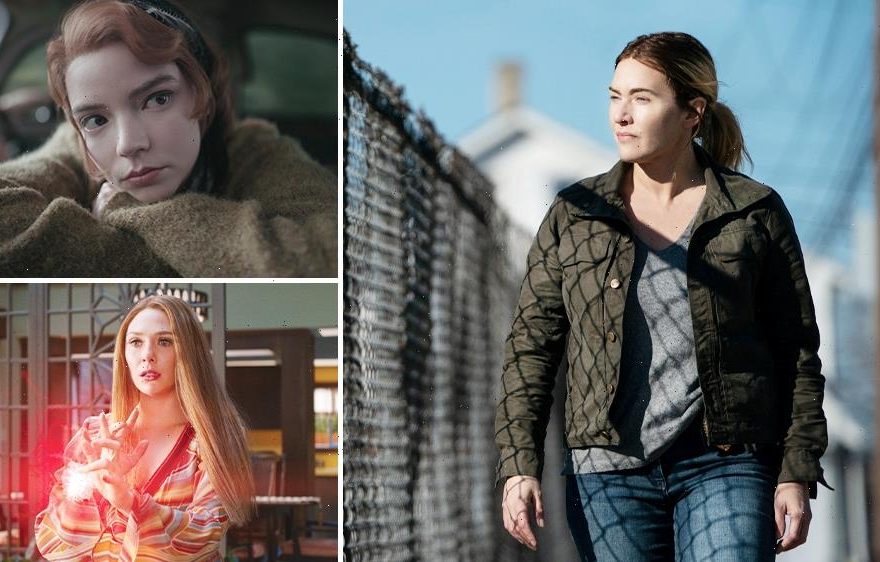Ever since she made a championship-winning basket in high school, Mare Sheehan (Kate Winslet) was the golden girl of the Easttown community, Miss Lady Hawk herself.
A small-town cop when HBO’s “Mare of Easttown” introduces her, she has been regarded as a hero. But she is failing to live up to her neighbors’ and her own lofty expectations, unable to grieve the death of her son and solve the case of a missing teenager. “What’s interesting to me is that she had always embraced the title of being a hero. As much as she complains about it, she’s allowed the community to have this image of her over the years. And now we drop into her life at this exact moment when the facade is crumbling,” says “Mare of Easttown” showrunner Brad Ingelsby. He wanted to write a character who still viewed herself as a “bedrock” of her community, despite that rock displaying serious faults. “She hasn’t been able to solve the case of Katie, so the community that embraced her is now starting to turn on her.”
Similarly, “The Queen’s Gambit’s” Beth Harmon (Anya Taylor-Joy) and “WandaVision’s” Wanda Maximoff (Elizabeth Olsen) struggle to deal with the burden that comes with being on such a high pedestal. Beth, in the Netflix limited series, is a chess prodigy living with an addiction, while on the Disney Plus limited series, the superpowered Wanda creates a fake suburban life because she refuses to face the death of her love. For these women, the pressure of being considered extraordinary can take its toll.
Mare has been “juggling chainsaws,” as Ingelsby puts it, for quite some time, and they have all hit the ground when the show begins. The series’ central questions are whether Mare will be able to piece herself and her family back together again, and how will she cope with her “second life”?
In the end, Ingelsby says it’s Mare’s resilience that allows her to move on — to climb up into the attic where her son died by suicide and face her past. Making that shift is something she needs to do, he continues, to come “to terms with the fact that [his death] wasn’t her fault.”
“It’s that attitude of, ‘I’m just going to get up in the morning; I’m going to put on my shoes and go to work. If I keep moving, I’ll be OK.’ I think that’s an admirable quality in Mare,” Ingelsby says.
Like Mare, Beth in “The Queen’s Gambit” launches herself into her career and uses her considerable talent as a coping mechanism for the trauma of her past.
She is willing to do whatever it takes to become the world chess champion, to prove that she’s the greatest chess player on the planet. However, in doing so she sacrifices relationships and connections she needs.
“We wanted to explore the cost of genius,” says “Queen’s Gambit” executive producer William Horberg. “Beth has to find a commensurate ability to reconnect with real life and form meaningful relationships. I think what touches us is not only the story of her survival, but her resilience and her acceptance that you can’t just be an island, you can’t just be alone. She has to embrace the family that she’s built.”
Although there is external pressure from the U.S. government and from her rivals to be the best, “Beth is her own worst enemy,” explains Horberg, as recurring addiction problems and self-doubt almost checkmate her.
She benefits from more than a few helping hands to achieve her dream, but ultimately, it’s the chess match in her mind that’s almost the harder one to win.
“The show is about watching her growing up and attempting to wrestle with her own demons and control them and find, within the confines of this game, a place where she can feel secure and dominate,” Horberg says.
Another character with the weight of the world on her shoulders, who never felt stable in any one place, is the witchy Wanda. In her often-fleeting Marvel Cinematic Universe appearances prior to the new series, she was seemingly either letting her fiery emotions get the better of her or being kept under lock and key for fear of her power exploding.
Jac Schaeffer, executive producer and head writer of “WandaVision” was delighted to “have the runway” to be able to dig deeper into the character’s past and to give her a taste of what a stable family life might look like.
“Wanda has had so little of her own — she has had so few opportunities in her life to call a place her home, or to say, ‘This person is my person, this job is my job,’” Schaeffer says. “Things have been wrenched from her time and again, and I think the domestic and motherhood pieces of the show are her saying, ‘These are my babies. I can love them fully with my whole heart.’”
Schaeffer wanted to present a more holistic female superhero after seeing the “stories of women with extraordinary powers mishandled in the genre space.” But even as Wanda struggles internally, resulting in catastrophic external actions, it was also important to Schaeffer to not keep her the “very serious, at times melancholy character” she often — and justifiably — has been in the movies.
“We knew we were going to be exploring the root of her deep sadness, but I was excited at the opportunity to front-load the joy and sparkle and charisma that I know Elizabeth Olsen had in her.,” says Schaeffer. “Her fizziness always felt such a key part of the show.”
Source: Read Full Article
